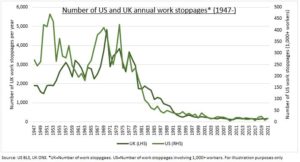WAGES: UK faces a ‘summer of discontent’ as labour strikes build after nationwide rail strikes. This is worsened by wage growth lagging well behind 9% inflation. The UK may be the global ‘stagflation’ poster child but the US and Continent are not far behind. Large US work stoppages are up 30% vs last year. But this discontent is still a small fraction of the 1970’s (see chart) and likely shorter-lived. Central Banks on front foot, long-term inflation expectations well anchored, labour markets set to cool. But the workforce has changed, driving investment opportunities.
STRIKES: Spare a thought for 1970’s when labour stoppages were 20 times recent US and UK levels. This decline now reflects a fall of union membership, to 10% in US and 23% in UK, now focused 4:1 on the public sector. Also the rise of more flexible work arrangements. For example, 27% of UK workers are now temporary, 13% self-employed, and 6% with second jobs. Plus the higher-for-longer inflation of the 1970’s was more chronic and entrenched than conditions today.
IMPLICATIONS: But work has changed, and this has been accelerated by the recent pandemic. We have seen structural shifts to remote work, driving cloud, video conferencing, and employee integration solutions demand. See @RemoteWork. Also new business models have emerged alongside the rise of freelancing, from ridesharing to delivery. See @GigEconomy. Meanwhile poorer demographics and rising wages have been a structural boost to automation and robotics. See @5GRevolution This has all helped support corporate profit margins near historic records.

All data, figures & charts are valid as of 27/06/2022

